
 |
JPL's Wireless Communication Reference WebsiteChapter:
Analog and Digital Transmission
|
In a multipath channel, most conventional modulation techniques are sensitive to intersymbol interference unless the channel symbol rate is small compared to the delay spread of the channel. OFDM is significantly less sensitive to intersymbol interference, because a special set of signals is used to build the composite transmitted signal. The basic idea is that each bit occupies a frequency-time window which ensures little or no distortion of the waveform. In practice, it means that bits are transmitted in parallel over a number of frequency-nonselective channels. Applications of OFDM are found in
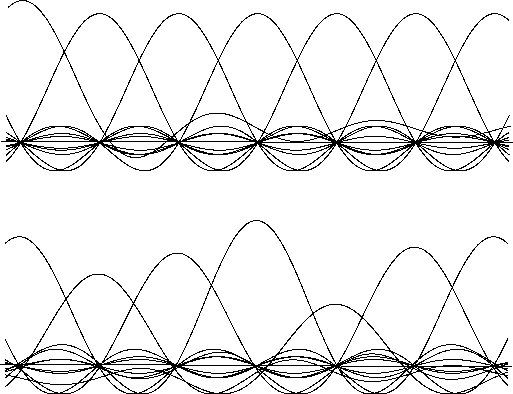
 The
effect of multipath scattering on OFDM
differs from what happens to other forms of modulation. A qualitative
description and mathematical description of OFDM
is presented by Dusan Matic. Jean-Paul Linnartz reviews the effects
of a Doppler spread and the associated rapid channel variations. Dusan Matic
also studied the system design aspects of OFDM at mm-wavelengths.
The
effect of multipath scattering on OFDM
differs from what happens to other forms of modulation. A qualitative
description and mathematical description of OFDM
is presented by Dusan Matic. Jean-Paul Linnartz reviews the effects
of a Doppler spread and the associated rapid channel variations. Dusan Matic
also studied the system design aspects of OFDM at mm-wavelengths.
Multi-Carrier Modulation on its own is not the solution to the problems of communication over unreliable multipath channels. The channel time dispersion will excessively attenuate some subcarriers such that the throughput on these sub-channels would be unacceptable small. Only if the joint signal of many subcarriers is processed appropriately, the diversity advantages of MCM can be exploited. The need for coding across subcarriers was addressed by Sari et al. warning against overly enthusiastic pursuit of MCM. The advantages of frequency-domain implementations of equalizers (using an FFT) should not be mistaken for an "inherent" diversity gain of OFDM, which may not exist.
|
|
Coding for wireless |
In an OFDM transmitter, blocks of k incoming bits are encoded into n channel bits. Before transmission, an n-point Inverse-FFT operation is performed. When the signals at the I-FFT output are transmitted sequentially, each of the n channel bits appears at a different (subcarrier) frequency. Such coding across subcarriers is necessary. If one subcarrier experiences deep fading, this leads to erasure of the bit on this subcarrier.
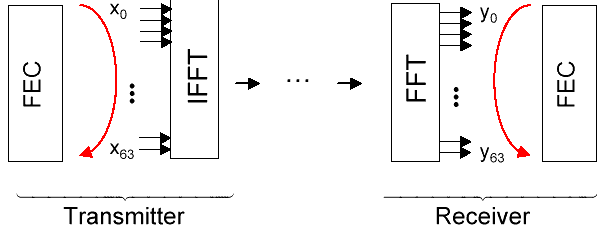
But of course coding across subcarriers is not the only mechanism that can be invoked to combat dispersion or to exploit diversity. Other possibilities are
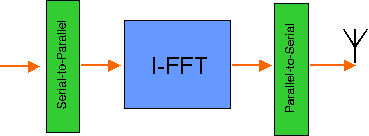 |
Figure: OFDM transmitter using an (inverse) Fast Fourier Transform (FFT).
|
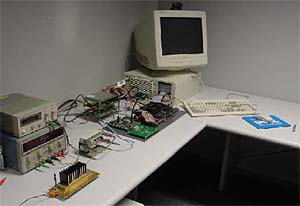 |
Figure: Experimental OFDM transceiver at IMEC, Leuven. Slides from IMEC tutorials: intro, turbo coding, turbo for OFDM |
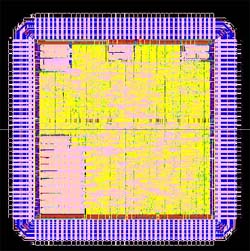 |
Many channel simulation models follow the narrowband model. Wideband channels are often simulated by extending the model assuming multiple time-delayed resolvable paths. This allows the simulation of the channel impulse response, including its stochastic behavior. To determine the performance of an multicarrier, OFDM or MC-CDMA system, another approach can be to model a set of fading subchannels. Considering a single subcarrier, the channel may be modelled as a narrowband fading channel, for instance with Rician or Rayleigh amplitude distributions. The collection of multiple subcarriers can be modelled as a set of mutually dependent fading channels. In such model, it is important to address correlation of the fading of various subchannels using the models of delay spread and coherence bandwidth. See a discussion of such model. Also: read about the discrete-frequency model for OFDM with Delay spread and Doppler.
 |
Listen to an MP3 audio program about on OFDM, featuring Jeff Anderson (SONY), Geert Awater (Lucent), Helmut Boelsckei (Stanford U.) and Jean-Paul Linnartz (Philips). |
| SMIL Synchronous Multimedia |
Animated audio tutorial on OFDM and MC-CDMA |